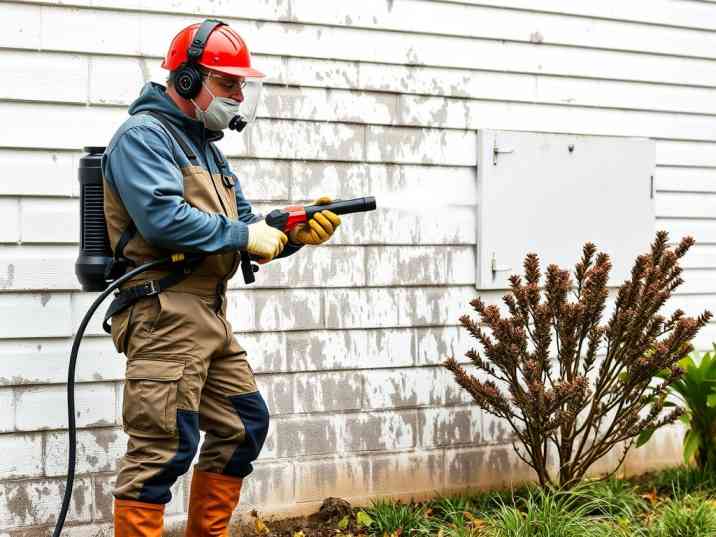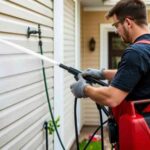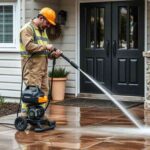Mold is a common yet persistent problem that can affect both the aesthetic appeal and structural integrity of your property. It thrives in damp, humid environments and can spread rapidly if not addressed promptly. While there are various methods to combat mold, power washing has emerged as one of the most effective techniques for removing mold from exterior surfaces. This article delves into the best practices for using power washing to eliminate mold, ensuring your property remains clean, safe, and visually appealing.
Understanding Mold and Its Impact
Before diving into the power washing techniques, it’s essential to understand what mold is and why it’s problematic. Mold is a type of fungus that grows in multicellular filaments called hyphae. It reproduces through spores, which can travel through the air and settle on surfaces. When these spores find a moist environment, they begin to grow and spread.
Mold not only causes unsightly stains but can also lead to health issues, especially for individuals with allergies or respiratory conditions. Prolonged exposure to mold can result in symptoms such as coughing, sneezing, skin irritation, and even more severe health problems. Additionally, mold can weaken the structural components of your property, leading to costly repairs if left unchecked.

Why Power Washing is Effective Against Mold
Power washing, also known as pressure washing, utilizes high-pressure water spray to remove dirt, grime, and mold from surfaces. The force of the water can penetrate porous materials, effectively dislodging mold spores and preventing them from regrowing. Here’s why power washing is particularly effective for mold removal:
- High Pressure: The intense pressure of the water can reach deep into cracks and crevices, ensuring that mold is thoroughly removed.
- Versatility: Power washing can be used on a variety of surfaces, including concrete, wood, brick, and vinyl siding.
- Efficiency: It is a quick and efficient method, capable of covering large areas in a relatively short amount of time.
- Eco-Friendly: When combined with environmentally friendly cleaning solutions, power washing can be a green cleaning option.
Step-by-Step Guide to Removing Mold with Power Washing
1. Safety First: Prepare Yourself and the Area
Before you begin power washing, it’s crucial to prioritize safety. Mold spores can be harmful when inhaled, and the high-pressure water can cause injury if not handled properly. Here’s how to prepare:
- Protective Gear: Wear protective clothing, including gloves, goggles, and a mask or respirator to prevent inhalation of mold spores.
- Clear the Area: Remove any furniture, plants, or other items from the area to be cleaned. Cover nearby plants and electrical outlets with plastic sheeting to protect them from water damage.
- Inspect the Surface: Check the surface for any cracks or damage that could be exacerbated by the high-pressure water. Repair any issues before proceeding.
2. Choose the Right Equipment
Selecting the appropriate power washing equipment is essential for effective mold removal. Consider the following factors:
- Pressure Washer Type: Electric pressure washers are suitable for lighter jobs, while gas-powered models offer more power for tougher stains.
- Nozzle Selection: Use a nozzle with a 25- to 40-degree spray angle for mold removal. A narrower angle provides more pressure but can damage surfaces, so adjust accordingly.
- Cleaning Solution: Some pressure washers have a detergent tank for applying cleaning solutions. Choose a mold-killing solution that is safe for the surface you’re cleaning.
3. Apply a Mold-Killing Solution
Before power washing, it’s beneficial to apply a mold-killing solution to the affected area. This helps to loosen the mold and makes it easier to remove. Here’s how to do it:
- Mix the Solution: Prepare a solution of water and a mold-killing detergent. Alternatively, you can use a commercial mold remover.
- Apply Evenly: Use a garden sprayer or the detergent tank on your pressure washer to apply the solution evenly across the surface.
- Let it Sit: Allow the solution to sit for 10-15 minutes to penetrate the mold and break it down.
4. Power Wash the Surface
Now that the surface is prepped, it’s time to power wash. Follow these steps for optimal results:
- Start from the Top: Begin at the top of the surface and work your way down. This prevents streaking and ensures that loosened mold is washed away.
- Maintain a Consistent Distance: Keep the nozzle 12-18 inches away from the surface to avoid damage while still effectively removing mold.
- Overlap Strokes: Use overlapping strokes to ensure even coverage and prevent missed spots.
- Rinse Thoroughly: After power washing, rinse the surface with clean water to remove any remaining detergent or mold residue.
5. Post-Cleaning Maintenance
Once the mold has been removed, it’s important to take steps to prevent its return:
- Dry the Area: Ensure the surface is completely dry to prevent mold from regrowing. Use fans or allow natural sunlight to aid in drying.
- Inspect for Residual Mold: Check for any remaining mold spots and re-treat if necessary.
- Apply a Mold Inhibitor: Consider applying a mold inhibitor to the surface to prevent future growth. These products create a protective barrier that discourages mold from taking hold.
Tips for Effective Mold Removal with Power Washing
- Test on a Small Area: Before power washing the entire surface, test on a small, inconspicuous area to ensure the pressure and cleaning solution won’t cause damage.
- Avoid Over-Pressurizing: Using too much pressure can damage surfaces, especially softer materials like wood. Adjust the pressure according to the surface type.
- Regular Maintenance: Regularly inspect and clean your property to prevent mold from becoming a recurring issue.
- Professional Help: For extensive mold problems or hard-to-reach areas, consider hiring a professional power washing service. They have the expertise and equipment to handle the job safely and effectively.
Conclusion
Mold is a persistent issue that can compromise both the appearance and structural integrity of your property. Power washing offers an effective solution for removing mold from exterior surfaces, provided it is done correctly. By following the steps outlined in this article—preparing the area, choosing the right equipment, applying a mold-killing solution, power washing thoroughly, and maintaining the surface—you can effectively eliminate mold and prevent its return.
Remember, safety is paramount when dealing with mold and power washing. Always wear protective gear and take necessary precautions to protect yourself and your property. With the right approach, power washing can restore your surfaces to their original condition, ensuring a clean, healthy, and visually appealing environment.
By incorporating these power washing techniques into your regular maintenance routine, you can keep mold at bay and enjoy a pristine property for years to come.





